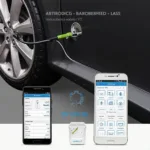The dreaded error obd2 p0500, indicating a vehicle speed sensor (VSS) malfunction, can be a frustrating experience. This comprehensive guide dives into the complexities of the P0500 code, explaining its causes, symptoms, diagnostic procedures, and solutions, equipping you with the knowledge to tackle this issue head-on.
What is the OBD2 Error P0500?
The P0500 code signifies a problem with the vehicle speed sensor, a crucial component that monitors the speed of your vehicle and relays this information to the engine control unit (ECU). This data is essential for various systems, including the transmission, anti-lock brakes (ABS), and cruise control. A malfunctioning VSS can disrupt these systems and lead to drivability issues.
Symptoms of a P0500 Error Code
A faulty VSS can manifest in several ways, affecting your vehicle’s performance and safety. Some common symptoms include:
- Erratic or inaccurate speedometer readings
- Intermittent ABS activation
- Cruise control malfunction
- Rough shifting or transmission problems
- Reduced fuel efficiency
- Check Engine Light illuminated
Diagnosing the OBD2 Error P0500
Pinpointing the root cause of the P0500 code requires a systematic diagnostic approach. Start by visually inspecting the VSS and its wiring for any damage or loose connections. Next, you’ll need an obd2 error p0500 scanner to retrieve any stored codes and monitor live data from the VSS. This will help determine if the sensor itself is faulty or if the issue lies elsewhere in the system.
Checking the Vehicle Speed Sensor
Using a multimeter, you can test the VSS for proper resistance and voltage output. Compare your readings with the manufacturer’s specifications to determine if the sensor is functioning within the acceptable range.
Inspecting the Wiring and Connectors
Faulty wiring or corroded connectors can also trigger a P0500 code. Thoroughly examine the wiring harness for any breaks, shorts, or damage. Ensure all connectors are securely fastened and free of corrosion. Cleaning or replacing damaged wiring or connectors can often resolve the issue.
“A common oversight is neglecting to check the wiring harness thoroughly. A simple break in the wiring can cause the P0500 code and lead to unnecessary sensor replacement,” says automotive expert, Michael Carter, ASE Certified Master Technician.
Fixing the OBD2 Error P0500
Once you’ve identified the cause of the P0500 code, you can take appropriate action to fix it. This may involve replacing the VSS, repairing damaged wiring, or cleaning corroded connectors. In some cases, a simple obd2 scanner battery reset might be all that’s needed.
Replacing the Vehicle Speed Sensor
Replacing the VSS is a relatively straightforward process that can often be done with basic tools. Locate the sensor, usually mounted on the transmission or differential, and disconnect the electrical connector. Remove the old sensor and install the new one, ensuring it’s properly seated and connected.
“Investing in a quality OBD2 scanner, such as the hh obd2 bluetooth, can save you time and money in the long run by allowing you to quickly diagnose and resolve issues like the P0500 code,” adds Carter. This makes monitoring data simpler and even connects to a head unit, like the popular obd2 head unit display.
Conclusion: Conquering the P0500 Code
Understanding the error obd2 p0500 is essential for maintaining your vehicle’s performance and safety. By following the diagnostic and repair procedures outlined in this guide, you can confidently address this common issue and get back on the road.
FAQ
- What does the P0500 code mean? The P0500 code indicates a problem with the vehicle speed sensor.
- Can I drive with a P0500 code? It’s not recommended, as it can affect various vehicle systems.
- How much does it cost to fix a P0500 code? The cost varies depending on the repair needed.
- What tools do I need to diagnose a P0500 code? An obd2 plus app and a multimeter are helpful tools.
- How do I prevent a P0500 code? Regular vehicle maintenance can help prevent this code.
Need help with your P0500 code? Contact us via WhatsApp: +1(641)206-8880, Email: [email protected] or visit us at 789 Elm Street, San Francisco, CA 94102, USA. We have a 24/7 customer support team.
